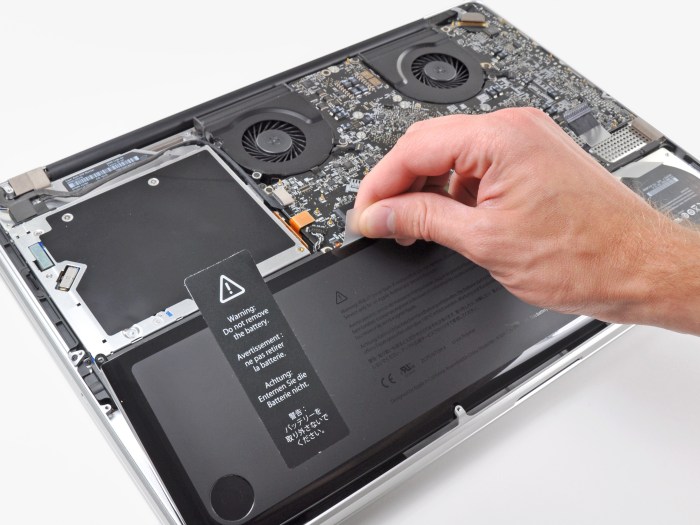Easy Guide to Ruining Apple MacBook Battery: Ever wondered how to quickly drain the life out of your prized MacBook battery? We’ve all been there, staring at that dreaded low battery icon with a sigh. But what if you’re not just experiencing normal wear and tear?
This guide delves into the common pitfalls that can accelerate battery degradation, leaving your MacBook gasping for power.
From charging habits to software settings, we’ll uncover the hidden culprits behind premature battery failure. We’ll explore how excessive heat, prolonged inactivity, and even physical damage can significantly shorten your battery’s lifespan. Armed with this knowledge, you can make informed decisions to extend the life of your MacBook’s battery and avoid those dreaded battery-related frustrations.
Understanding Battery Degradation

Every MacBook battery has a limited lifespan. This means that over time, the battery will gradually lose its ability to hold a charge, leading to shorter battery life. This process is known as battery degradation, and it’s a natural part of the battery’s lifecycle.
Factors Contributing to Battery Degradation
Several factors can contribute to the rate of battery degradation. These include:
- Temperature:Extreme temperatures, both hot and cold, can significantly accelerate battery degradation. Keeping your MacBook in a cool, dry environment is essential for maximizing battery life.
- Charging Habits:Constantly keeping your battery at 100% or letting it completely drain can also contribute to faster degradation. It’s best to keep your battery within the 20% to 80% range for optimal performance.
- Battery Age:Over time, all batteries will degrade, even if they’re not used. This is simply due to the natural aging process of the battery’s chemical components.
- Usage Patterns:Heavy usage, such as running demanding applications or playing graphics-intensive games, can put more stress on the battery, leading to faster degradation.
Typical Lifespan of a MacBook Battery
The lifespan of a MacBook battery can vary depending on factors such as usage patterns, charging habits, and environmental conditions. However, Apple estimates that a typical MacBook battery will retain around 80% of its original capacity after 500 charge cycles.
A charge cycle is defined as completely draining the battery and then charging it back to 100%.
Battery Life of Different MacBook Models
The following table compares the battery life of different MacBook models, based on Apple’s official estimates:
| Model | Battery Life (Hours) |
|---|---|
| MacBook Air (M2, 2022) | 18 |
| MacBook Pro 13-inch (M2, 2022) | 17 |
| MacBook Pro 14-inch (M1 Pro, 2021) | 17 |
| MacBook Pro 16-inch (M1 Pro, 2021) | 21 |
Common Battery Ruining Habits

While we all want our Macbooks to last as long as possible, our daily habits can unknowingly contribute to battery degradation. Understanding these habits and making simple changes can significantly extend your battery’s lifespan.
Excessive Heat Impact
Heat is a major culprit in accelerating battery degradation. Lithium-ion batteries, the type found in Macbooks, are sensitive to high temperatures. When exposed to excessive heat, their chemical composition can be altered, leading to a decrease in capacity and overall lifespan.
“Excessive heat is the enemy of battery life. It can cause the battery to degrade more quickly, leading to a shorter lifespan.”
Apple Support
Common Battery Draining Habits
Here are some common habits that can contribute to battery drain:
- Leaving your Macbook plugged in all the time:While convenient, constantly charging your Macbook can lead to overcharging, which can stress the battery and reduce its lifespan.
- Using your Macbook in extreme temperatures:Whether it’s a hot car or a freezing cold room, extreme temperatures can damage your battery. Try to use your Macbook in moderate temperatures, ideally between 50°F and 95°F (10°C and 35°C).
- Running demanding applications:Games, video editing software, and other resource-intensive applications can drain your battery quickly. Consider closing unnecessary applications when not in use to conserve battery power.
- Keeping your screen brightness at maximum:A bright screen can consume a lot of battery power. Lowering the screen brightness can significantly improve battery life.
- Leaving Bluetooth and Wi-Fi enabled when not in use:These features can drain battery power even when not actively used. Turn them off when not needed.
- Using low-quality charging cables and adapters:Using cheap or damaged charging cables and adapters can lead to inconsistent charging and potentially damage your battery.
Prolonged Inactivity
Even when not in use, your Macbook’s battery can still drain. This is due to background processes and services that continue to run even when your Macbook is asleep. To avoid this, consider:
- Closing unnecessary applications before putting your Macbook to sleep:This reduces the number of background processes that drain battery power.
- Disabling features like Bluetooth and Wi-Fi when not in use:This further reduces background activity and conserves battery power.
- Using the “Low Power Mode” feature:This feature reduces battery consumption by limiting background processes and reducing screen brightness.
Charging Practices and Battery Health
Your MacBook’s battery is a delicate component that can be affected by your charging habits. Understanding the optimal charging practices is crucial for maximizing its lifespan and ensuring you get the most out of your device.
Optimal Charging Range, Easy guide to ruining apple macbook battery
Maintaining your MacBook’s battery within a specific charging range is essential for its longevity. Apple recommends keeping the battery charge level between 40% and 80%. This range ensures that the battery isn’t constantly exposed to the extremes of full charge or complete discharge, which can accelerate degradation.
Impact of Full Charge and Complete Discharge
While completely draining your battery might seem like a good way to “reset” it, it can actually have negative effects on its health. Frequent full charges and complete discharges can cause stress on the battery cells, leading to faster degradation.
Similarly, leaving your MacBook plugged in all the time, even when it’s fully charged, can also negatively impact its battery life. This constant exposure to a high charge level can cause the battery to “overcharge” and degrade faster.
Recommended Charging Practices
The following table Artikels recommended charging practices for maximizing your MacBook battery life:
| Charging Practice | Description | Benefits |
|---|---|---|
| Charge to 80% | Limit charging to 80% whenever possible. | Reduces stress on battery cells, minimizing degradation. |
| Avoid Full Charge | Unplug your MacBook once it reaches 80%. | Prevents overcharging and extends battery life. |
| Avoid Complete Discharge | Recharge your battery before it reaches 20%. | Minimizes stress from deep discharges, extending battery life. |
| Use Original Charger | Always use the original Apple charger for your MacBook. | Ensures optimal charging current and voltage for your battery. |
| Calibrate Battery Occasionally | Fully charge and discharge your battery once a month. | Helps maintain battery accuracy and performance. |
Software Settings and Battery Usage
Your MacBook’s software settings play a crucial role in determining its battery life. By understanding how these settings affect power consumption, you can optimize your device for extended usage without worrying about frequent charging.
Find out about how russia building a satellite blinding laser expert technology can deliver the best answers for your issues.
Background Processes and Notifications
Background processes, running silently in the background, consume significant battery power. These processes include apps refreshing data, syncing files, or performing other tasks even when you’re not actively using them. Similarly, frequent notifications from apps can drain your battery quickly.
- Disable unnecessary background app refresh:To minimize background processes, go to Settings > General > Background App Refresh. Here, you can disable automatic updates for apps that don’t require constant updates. For example, you might disable background refresh for social media apps or news apps that you don’t need real-time updates from.
- Limit notifications:Reduce the number of notifications you receive by going to Settings > Notifications. Here, you can customize notification settings for individual apps. You can choose to receive fewer notifications, disable specific types of notifications (like sounds or banners), or turn off notifications altogether for apps you rarely use.
- Turn off location services:Location services, while useful for navigation and location-based apps, can drain your battery. Go to Settings > Privacy > Location Servicesand disable location services for apps that don’t require your location data.
Optimizing Software Settings for Battery Performance
Several software settings can be adjusted to improve battery performance. These settings control how your MacBook uses power and can have a significant impact on battery life.
- Reduce screen brightness:A brighter screen consumes more power. Lowering the screen brightness can significantly extend your battery life. Go to Settings > Displayand adjust the brightness level to a comfortable level.
- Enable low power mode:Low power mode reduces the power consumption of your MacBook by limiting background processes and reducing the performance of some features. You can enable low power mode in Settings > Battery. Low power mode can extend your battery life by several hours, making it a valuable tool for conserving power when you’re on the go.
- Turn off Bluetooth and Wi-Fi when not in use:Bluetooth and Wi-Fi are constantly searching for connections, consuming power even when you’re not using them. Turn off these features when you’re not actively using them by using the toggle switch in the menu bar or by going to Settings > Bluetoothand Settings > Wi-Fi.
- Disable automatic downloads and updates:Automatic downloads and updates can consume significant battery power, especially if you have a large amount of data to download. You can disable automatic downloads and updates in Settings > App Store.
- Minimize animations and effects:Visual effects, like animations and transitions, can drain your battery. You can reduce these effects by going to Settings > Accessibility > Reduce Motion. This setting will reduce the amount of motion and animation on your screen, resulting in a more power-efficient experience.
Physical Damage and Battery Health
Physical damage to your MacBook can significantly impact its battery performance and lifespan. Even seemingly minor impacts can compromise the delicate internal components, leading to a decline in battery capacity and charging efficiency.
Impact of Physical Damage on Battery Performance
Physical damage can affect the battery’s performance in various ways:* Internal Short Circuits:Impacts or drops can cause internal components to shift, potentially leading to short circuits within the battery. This can damage the battery cells and render them unusable.
Damaged Battery Cells
The battery cells themselves are delicate and can be easily damaged by physical impact. Damaged cells may lose their ability to hold a charge or experience an uneven discharge rate.
Connection Issues
Physical damage can disrupt the connection between the battery and the MacBook’s motherboard. This can prevent the battery from charging properly or even communicating with the device.
Overheating
A damaged battery may be more susceptible to overheating, which can further degrade its performance and shorten its lifespan.
Risks Associated with Dropping or Exposing the MacBook to Extreme Temperatures
Dropping or exposing your MacBook to extreme temperatures can have serious consequences for its battery:* Dropping:Dropping your MacBook, even from a short distance, can damage the battery cells, leading to a decrease in capacity and performance.
Extreme Temperatures
Exposing your MacBook to extreme temperatures, whether hot or cold, can significantly impact the battery’s performance and lifespan. Heat can accelerate the degradation of battery cells, while cold temperatures can reduce battery capacity and charging efficiency.
Thermal Runaway
In extreme cases, overheating can trigger a thermal runaway, a dangerous situation where the battery overheats uncontrollably and can potentially catch fire or explode.
Handling the MacBook to Prevent Physical Damage to the Battery
Here are some tips to protect your MacBook’s battery from physical damage:* Handle with Care:Always handle your MacBook with care, avoiding any sudden movements or drops.
Use a Protective Case
Invest in a sturdy protective case to cushion your MacBook from bumps and scratches.
Avoid Extreme Temperatures
Do not leave your MacBook in direct sunlight, near heat sources, or in extremely cold environments.
Proper Storage
When not in use, store your MacBook in a cool, dry place.
Avoid Overcharging
Overcharging your MacBook can put stress on the battery and shorten its lifespan.
Battery Replacement and Maintenance: Easy Guide To Ruining Apple Macbook Battery

When your MacBook’s battery starts showing signs of fatigue, it’s time to consider replacing it. While a new battery can breathe life back into your aging machine, it’s crucial to understand the process and make informed choices. This section will guide you through the process of replacing your MacBook’s battery, from recognizing the need for replacement to choosing the right battery and performing the replacement yourself.
Signs of Battery Degradation
A declining battery life is a clear indication that your MacBook’s battery needs replacement. While the battery’s lifespan varies depending on usage patterns, a few signs signal that it’s time for a new one.
- Rapid battery drain:You notice your MacBook’s battery depleting much faster than usual, even when performing light tasks. For instance, you might see your battery drop from 100% to 50% within a few hours of normal usage.
- Frequent charging:You find yourself constantly plugging in your MacBook to maintain a decent battery level. This signifies that the battery can no longer hold a substantial charge for an extended period.
- Swollen battery:A swollen battery is a serious warning sign. If you notice your MacBook’s bottom casing bulging or distorting, it’s crucial to stop using the device immediately and seek professional help.
- Reduced battery capacity:The battery icon on your MacBook may show a significantly lower capacity than its original rating, even after a full charge.
Choosing the Right Battery Replacement
Selecting the right battery for your MacBook is crucial for ensuring compatibility and optimal performance.
- Original Apple batteries:Apple offers genuine replacement batteries for their MacBook models. These batteries are designed to seamlessly integrate with your device and offer the best performance and reliability. However, they are typically more expensive than third-party options.
- Third-party batteries:Several reputable third-party manufacturers produce MacBook batteries. These options are often more affordable than Apple’s batteries, but it’s essential to research and choose a reputable brand known for quality and compatibility. Ensure the battery you choose is compatible with your specific MacBook model.
Replacing the MacBook Battery
Replacing a MacBook battery can be a delicate process, and it’s essential to approach it with caution.
- Prepare your workspace:Find a clean, well-lit area to work. You’ll need a Phillips screwdriver, a spudger (a plastic tool for prying open devices), and a heat gun or hairdryer (optional).
- Discharge the battery:Before you start, it’s crucial to discharge the battery completely. This reduces the risk of electrical shock. Disconnect your MacBook from power and let it drain until it shuts down completely.
- Remove the screws:Locate the screws holding the bottom case of your MacBook in place. These screws are usually located around the perimeter of the case. Use a Phillips screwdriver to remove them.
- Pry open the case:Use a spudger to gently pry open the bottom case of your MacBook. Start at one corner and work your way around the case, carefully separating it from the top case.
- Disconnect the battery:Locate the battery connector and carefully disconnect it from the motherboard. This is typically a small connector with a few wires.
- Remove the old battery:Carefully remove the old battery from your MacBook. You may need to use a spudger to gently pry it loose if it’s stuck.
- Install the new battery:Position the new battery in the designated space, ensuring it’s properly aligned. Connect the battery connector to the motherboard.
- Reassemble the case:Replace the bottom case and secure it with the screws you removed earlier.
- Power on your MacBook:Connect your MacBook to power and turn it on.


